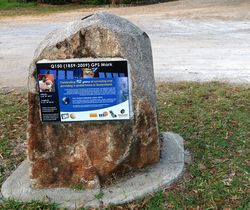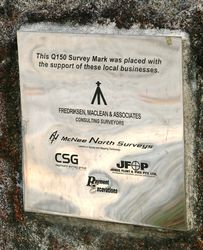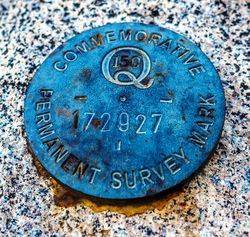
Home » Themes » Landscape » Settlement
Q150 GPS Mark Print Page 
The spatial sciences profession ( surveyors, map makers and those who work with location information ) placed over 60 GPS Marks at significant locations around Queensland during 2009 to commemorate the 150th anniversary of Queensland and 150 years.
The marks accurately depict latitude and longitude and provide the public with a means to check the accuracy of their in-car, in-boat and hand-held navigation devices.
The project was launched at the Museum of Lands, Mapping and Surveying in Brisbane on 24 June 2009.
Queensland's early explorers were often surveyors. Local members of SSSI (Surveying & Spatial Sciences Institute) Queensland will tell the stories of early surveyors and map makers by placing signs adjacent to many of the GPS Marks and celebrating 150 years of Queensland's history through public events celebrating the past and showcasing the future of the profession.
Location
| Address: | Bruce Highway, Calliope River Historical Village, River Ranch, 4680 |
|---|---|
| State: | QLD |
| Area: | AUS |
| GPS Coordinates: | Lat: -23.959656 Long: 151.151748 Note: GPS Coordinates are approximate. |
Details
| Monument Type: | Plaque |
|---|---|
| Monument Theme: | Landscape |
| Sub-Theme: | Settlement |
| Approx. Event Start Date: | 1859 |
| Approx. Event End Date: | 2009 |
Dedication
| Approx. Monument Dedication Date: | 2009 |
|---|
Q150 (1859 - 2009) GPS Mark
Celebrating 150 years of surveying and providing a spatial future in Queensland.
In 1853 the first surveyor of Gladstone, Francis Peter MacCabe, was appointed by the NSW Government to take a surveying party to the Port Curtis area to establish a settlement. MacCabe established the first allotments within Gladstone, and created suburban and farming allotments within the district around the area of West Stowe, The party also mapped the features of the district including mountains, rivers and roads.
Your Global Positioning system (GPS)
The GPS satelitte system used a constellation of 24+ satelitte, orbiting the earth twice a day and sending data down to your GPS unit. The data from three or more satellites is used to to calculate where it is on the surface of the earth.
The satellites send a signal that is picked up by the GPS receiver. The GPS uses that information to show where you are.







